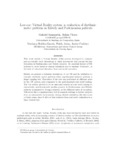Low-cost virtual reality system in evaluation of rhythmic motor patterns in elderly and Parkinsonian patients

Ver/Abrir
Use este enlace para citar
http://hdl.handle.net/2183/14518Colecciones
- Investigación (FCS) [1295]
Metadatos
Mostrar el registro completo del ítemTítulo
Low-cost virtual reality system in evaluation of rhythmic motor patterns in elderly and Parkinsonian patientsFecha
2014-04-30Cita bibliográfica
G. Sanmartín, J. Flores, V. Robles-García, P. Arias and J. Cudeiro, "Low-Cost Virtual Reality System in Evaluation of Rhythmic Motor Patterns in Elderly and Parkinson's Disease Patients," in Presence, vol. 22, no. 4, pp. 291-307, 1 Nov. 2013, doi: 10.1162/PRES_a_00159.
Resumen
[Abstract] This work details a Virtual Reality (VR) system developed to evaluate
and potentially treat alterations in hand movements and central rhythm
formation in Parkinsonian and Elderly subjects. An essential feature of VR
systems to prove useful in clinical evaluation and to warrant \Presence", is
the lack of behavioral distortion from real world execution.
Herein, we present a technical description of our VR and its validation to
evaluate rhythmic motor patterns when experimental subjects perform a
nger tapping test. Execution of the test was performed at di erent rates
in the VR system, and compared to the gold-standard real world testing.
The VR system proved to be as valid and reliable as real world testing to
characterize arrythmokinetic pro les present in Parkinsonian and Elderly
subjects (compared to Young subjects), at the di erent rates of execution.
VR serves like a complementary tool in research settings to isolate subjects
from un-naturalistic environment, during clinical evaluation, like lab-rooms
or brain scans, since it did not bias behavior from real world evaluation in a
basic clinical test.





